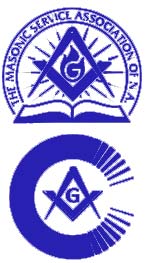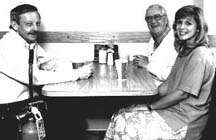

Richard E. Fletcher, 33
Executive Secretary, MSA & MIC
Silver Spring, Maryland
Two national Masonic organizations help the Craft meet
today’s challenges.
From its very beginning in 1919, the Masonic Service Association
of North America (MSA) has dealt with challenges to Freemasonry. In fact
the very formation of the Masonic Service Association was to meet a challenge.
Our original goal was to be a united effort on the part
of United States Grand Lodges to give assistance, aid, and comfort to our
uniformed military personnel. World War II saw Masonic Service Centers
in both this country and abroad to provide a relaxing and comfortable atmosphere
for soldiers and sailors.
After the war, thanks to the strong support of President
and Brother Harry Truman, 33, MSA began its Hospital Visitation Program.
A pioneer organization in assisting patients in V. A. Hospitals, MSA has
completed more than 50 years of volunteer service
Now, we must meet the new challenge of working with the
Veterans Association Volunteer Service (VAVS) in the transition of patient
service from mostly in-patient to mostly out-patient care. New opportunities
to assist our veterans in out-patient clinics and outside extended care
facilities challenge us to meet those needs.
Working with VAVS, the Masonic Service Association is
presently sponsoring a series of seminars to define current patient non-medical
needs and to develop a volunteer care plan to meet those needs. Our goal
is to involve every Masonic Lodge in this plan by urging each Lodge to
appoint volunteers to work with our MSA Hospital Representatives. Caring
for the sick and afflicted, with special emphasis on our veterans, is still
one of Freemasonry’s greatest challenges.
 Pictured
(l. to r.) are Roger Wells, a patient at the Veterans Administration Medical
Center in Madison, Wisconsin, who is awaiting a lung transplant. He is
drinking coffee with Teresa Chervenka, a Social Worker at the hospital,
and John (Jack) Miller, MSA volunteer at the Center. Roger Wells admitted
he was very nervous about the transplant operation and says he is supported
by “Jack Miller’s care and concern. Jack has opened his heart and home
to me. He is a warm person.” Miller says, “We hit it off right away, we
have a lot in common. I think the world of these guys and what they are
going through. It gives me a boost to do things for them and to meet their
families.” This is one story among thousands that could be told about the
care, concern and love given by MSA volunteers to the lonely and oftentimes
forgotten veterans in our Veterans Administration hospitals.
Pictured
(l. to r.) are Roger Wells, a patient at the Veterans Administration Medical
Center in Madison, Wisconsin, who is awaiting a lung transplant. He is
drinking coffee with Teresa Chervenka, a Social Worker at the hospital,
and John (Jack) Miller, MSA volunteer at the Center. Roger Wells admitted
he was very nervous about the transplant operation and says he is supported
by “Jack Miller’s care and concern. Jack has opened his heart and home
to me. He is a warm person.” Miller says, “We hit it off right away, we
have a lot in common. I think the world of these guys and what they are
going through. It gives me a boost to do things for them and to meet their
families.” This is one story among thousands that could be told about the
care, concern and love given by MSA volunteers to the lonely and oftentimes
forgotten veterans in our Veterans Administration hospitals.
The next Masonic challenge, after the V.A. Volunteer Program,
was to deal with Masonic education and information. The Short Talk Bulletin,
a monthly booklet on a subject of Masonic interest, has been published
since 1923. There are now almost 900 Short Talks in print. Many digests
and books, informational lists, videotapes, newsletters, and research resources
are also available. As has often been said, a well-informed Freemason is
our greatest asset.
A most difficult challenge was how to help those in dire
need from the effects of natural or man-made catastrophe. This challenge
was met by our Disaster Relief Program. An appeal is made by the Masonic
Service Association to all North American Grand Lodges on behalf of a stricken
Grand Lodge when a catastrophe occurs.
From its initial appeal, which resulted in a donation
of $1,577 to provide earthquake relief to Japan in 1923, to the most recent
appeal in 1997 to provide $165,000 in flood relief for Minnesota and North
Dakota, the MSA Disaster Relief Program has sent Grand Lodges nearly $4,000,000.
There were no administrative fees or costs of any kind deducted from the
amounts given.
Normally, the appeals are made to help in the recovery
from such natural disasters as earthquakes, floods, or hurricanes. However,
a man-made disaster, like the bombing in Oklahoma City, resulted in a magnificent
response ($89,962) to all those in need.
The latest Masonic challenge to be addressed is that of
media and public awareness. Freemasons have not been actively present in
the public eye for at least the last 30 years. As a result, vicious attacks
on our Fraternity by a few extremists have had greater effect than in years
past, primarily because the public has no basis of comparison.
The good work done by Freemasons is not noticed the way
it used to be, and when we are called Satan-worshippers, the general public
often has not heard any other opinion. This situation was a cause of great
concern to Ill. John J. Robinson, 33. Because of his foresight and insistence,
the Masonic Information Center (MIC) came into being in February 1993.
The Masonic Information Center has published a number
of brochures and booklets that respond to the religious extremists’ criticism
of our Fraternity. (See facing page.) The Center is also becoming known
to the media, and we are being interviewed about Freemasonry by both print
and audio/visual media. Also, we have established good contacts with the
Catholic Church and are attempting to resolve misunderstandings that have
existed for centuries. Conspiracy theories, unjust accusations, and fear
mongering cannot be overcome overnight, but steady progress is being made
by the Masonic Information Center.
To meet the challenge of membership in the Masonic Service
Association, in 1996, we changed our Constitution so that we are now the
Masonic Service Association of North America. As a result of this change,
several Canadian Grand Lodges are now members of the Masonic Service Association.
Challenges are with us always, and they are a necessary
part of life. The overall purpose of both the Masonic Service Association
and the Masonic Information Center is to work with the Grand Lodges and
other Masonic Bodies to assure that Freemasonry is always able to give
a strong, timely, and positive response to those great challenges.
MASONIC INFORMATION CENTER
Publishing Factual Information About Freemasonry
BROCHURES
A Response To Critics Of Freemasonry
Brochure responding to several alleged points of conflict
between Masonry and Christian theology. #BR-120 5¢ each (any quantity)
plus shipping.
Facts About Freemasonry
Brochure answering many of the most frequently asked questions
about the Fraternity. #BR-110 5¢ each (in any quantity) plus shipping.
BOOKLETS
There Is No Sin In Symbols
16-page booklet showing pictures and explanations of symbols
used in everyday life and symbols used by Masons and Masonic-related organizations
with explanations about their origin and meaning. #BL-201 25¢ each
(PPD); 40% discount in lots of 50 or more copies, plus shipping.
What’s A Mason?
16-page booklet describing the Masonic Fraternity and
its purposes. Explains what happens in Lodge meetings and answers many
frequently asked questions about the Fraternity. #BL-202 25¢ each
(PPD); 40% discount in lots of 50 or more copies, plus shipping.
BOOKS
Is It True What They Say About Freemasonry?
By Art deHoyos and S. Brent Morris (foreword and addendum
by Jim Tresner). A response to some of the more virulent anti-Masons, this
book takes on several of Masonry’s critics and refutes their charges. For
example, Albert Pike and the “Luciferian” doctrine; James Dayton Shaw’s
“exposé” of Freemasonry; Ron Carlson’s lectures on the “Evils of
Freemasonry” are discussed and refuted on a point-by-point basis. The 1997
Second Edition is updated with 100 pages of new material. Available through
MIC @ $7.50 (PPD); quantity purchase (50 or more) 40% discount, plus shipping.
Pictured
(l. to r.) are Roger Wells, a patient at the Veterans Administration Medical
Center in Madison, Wisconsin, who is awaiting a lung transplant. He is
drinking coffee with Teresa Chervenka, a Social Worker at the hospital,
and John (Jack) Miller, MSA volunteer at the Center. Roger Wells admitted
he was very nervous about the transplant operation and says he is supported
by “Jack Miller’s care and concern. Jack has opened his heart and home
to me. He is a warm person.” Miller says, “We hit it off right away, we
have a lot in common. I think the world of these guys and what they are
going through. It gives me a boost to do things for them and to meet their
families.” This is one story among thousands that could be told about the
care, concern and love given by MSA volunteers to the lonely and oftentimes
forgotten veterans in our Veterans Administration hospitals.